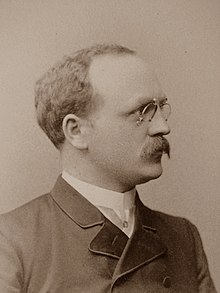This article needs additional citations for verification. (August 2017) |

Carl P. Pulfrich (September 24, 1858 in Burscheid, Rhine Province, Kingdom of Prussia – August 12, 1927 in Baltic Sea, drowned when his canoe capsized) was a German physicist, noted for advancements in optics made as a researcher for the Carl Zeiss company in Jena around 1880, and for documenting the Pulfrich effect,[1] a psycho-optical phenomenon that can be used to create a type of 3-D visual effect.[2] Carl Pulfrich was the brother-in-law of Heinrich Hertz.[3]
- ^ Pulfrich, Carl P. (1922). "Die Stereoskopie im Dienste der isochromen und heterochromen Photometrie". Naturwissenschaften. 10 (25): 553–564. Bibcode:1922NW.....10..553P. doi:10.1007/bf01571319. S2CID 32802850.
- ^ Petzold, Axel (2009). "The Historical Origin of the Pulfrich Effect: A Serendipitous Astronomic Observation at the Border of the Milky Way" (PDF). Neuro-Ophthalmology. 33 (1–2): 39–46. doi:10.1080/01658100802590829. S2CID 15422373.
- ^ Appleyard, Rollo (October 1927). "Pioneers of Electrical Communication--Heinrich Rudolf Hertz--V". Electrical Communication. 6 (2): 63–77.